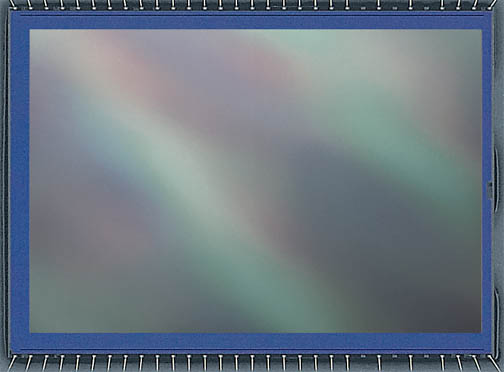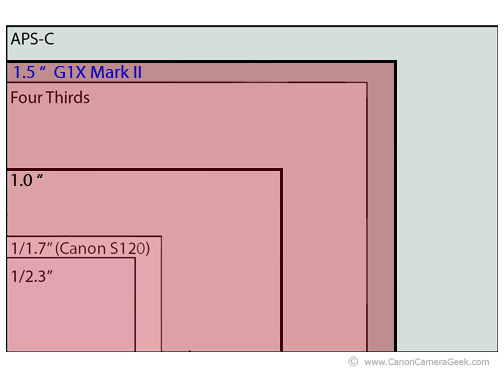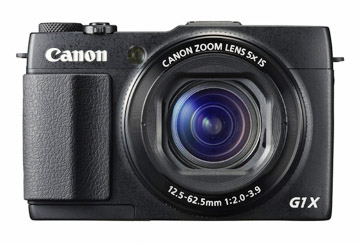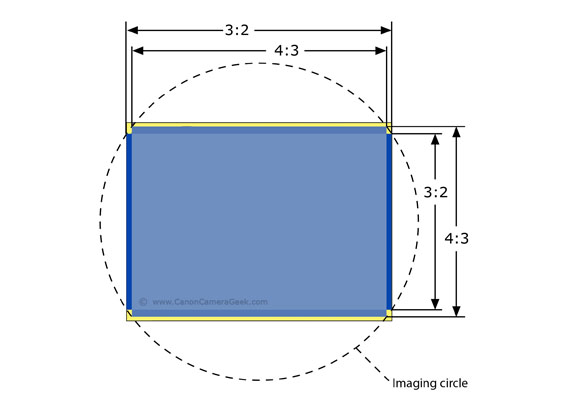Canon G1X Mark II Sensor
The Canon G1X Mark II sensor is almost as large as the Canon APS-C sensor, like the ones found in the Canon Rebel "ti" series, the Canon t3i, t4i, t5i, 6i, and t7i, as well as the EOS 10D through 70D, 80D, and 90D series of Canon cameras, and the Canon SL1, SL2, and SL3.
 Canon Digital Camera Sensor Close-up
Canon Digital Camera Sensor Close-upTHE LARGE SIZE OF THE G1X MARK II SENSOR IN SUCH A COMPACT CAMERA ARE THE BIGGEST REASONS PHOTOGRAPHERS BUYTHE CAMERA
The 1.5 inch G1X Mark II sensor is almost as big as the prosumer APS-C camera sensors. That gives you superior image quality over the typical point and shoot cameras or smartphone cameras.
 Sensor Size Comparison
Sensor Size ComparisonIt was a smart move for Canon to design a compact camera with such a nice big sensor packed inside. That's a big improvement over the 1/1.7 inch sensor you find in the s120 and the more recent Canon "G" series like my Canon G11.
CANON G1X MARK II SENSOR SPECS
- MAX RESOLUTION: 4160 x 3120
- IMAGE RATIO W:H 1:1, 5:4, 4:3, 3:2, 16:9
- SENSOR SIZE:1.5″ (18.7 x 14 mm)
- EFFECTIVE PIXELS: 13 megapixels
MULTI-aspect Ratio Canon G1X Mark II Sensor
One of the cool features of the Canon Powershot G1X Mark II sensor is the ability to shoot with different aspect ratios. The diagram below shows the two most well-known aspect ratios of 3:2 and 4:3.
The Mark II can easily be switched between different aspect ratios with the "function set" button on the back of the camera.
The G1X Mark II also allows you to use 16:9, a square 1:1 ratio, and the standard "portrait" aspect ratio of 4:5 when you shoot photographs. The photos below show the compositions you get when using these "crops" of the sensor.
 "Square" Format "Square" Format |
 "Portrait" Mode "Portrait" Mode |
Camera technology has advanced so much in the last decade. So many creative aspects of photography have emerged that it's easy to forget to just have fun with your digital photography.
The G1X Mark II has 12.8 megapixels used on the sensor when the default 3:2 aspect ratio is selected and is only slightly different when you select the 4:3 ratio. In either case a sensor this size gives much better high ISO performance and better intentional out-of-focus backgrounds which are great for shooting portraits.
 G1X Mark II Camera
G1X Mark II CameraWhen I first tested the Mark II at high ISO setting I was pleasantly surprised at the noise levels. I confess that was my biggest disappointment with my Canon G11. Anything at ISO 400 or higher was really only suitable for sharing on social media.
I compared the noise this sensor produces between the RAW files and the ones produced from the Digic 6 processor and some of the high ISO performance credit must be given to the G1X Mark II processor.
I know from my research that larger sensor-equipped cameras are generally much better performing at higher ISOs than many of the typical point and shoot sensor cameras. Enjoy the new technology of digital photography and the Canon G1X Mark II sensor.
Keep shooting your Canon!


Bruce Lovelace is the publisher of Canon Camera Geek. Read more about him on the About Page. He also publishes how to articles and camera gear reviews at the Photography Tips website.
View some of Bruce's photos on Instagram and Flickr. Join the tribe of followers on YouTube. Bruce also runs photo workshops and provides 1 on 1 digital photography coaching.
Search for articles on this Site:
Recent Articles
-
Choose the Right Memory Card for Your Canon R6 Mark II: Speed And Size
Nov 05, 25 02:04 PM
R6 Mark II Memory Card -
Canon G1x Mark II vs G1X-Side By Side Comparison of Canon G1X Cameras
Oct 22, 25 08:35 AM
G1 X Mark II vs. G1 X: Is the New Version a HUGE Leap... Or a Massive Mistake? Canon responded to the criticisms of the original G1X. Canon G1X Mark II vs G1X -
Sony RX100 III vs G1x Mark II by Canon. Side by Side Comparison
Oct 22, 25 08:07 AM
It's another one of those epic camera battles, this time not the Canon vs Nikon but rather the RX100 III Vs G1X Mark II battle.
This page may contain affiliate links that pay me a small commission. There is no cost to you. Review the affiliate statement at the very bottom of this page if you want more information.

























